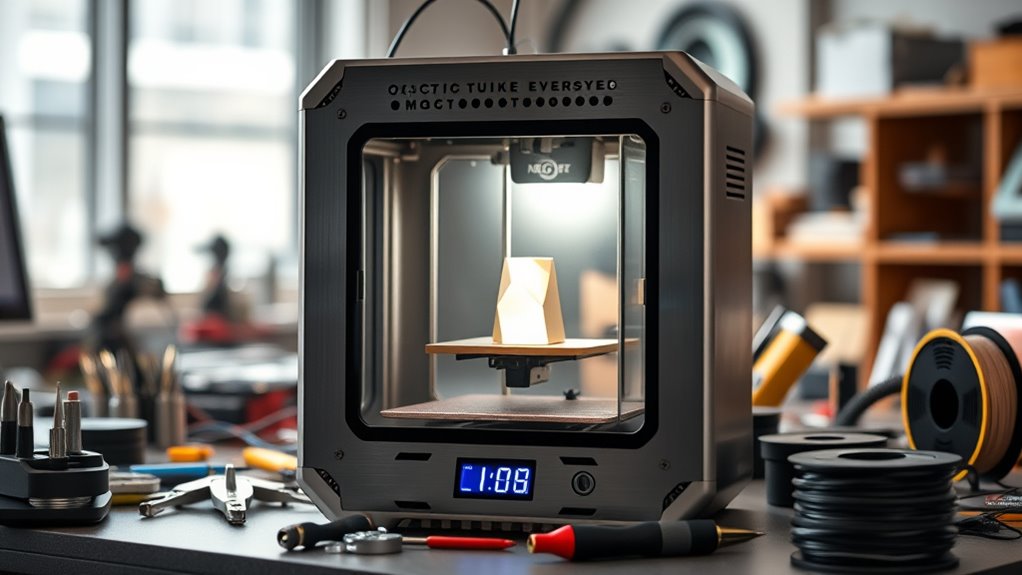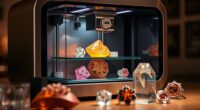If you’re looking for the best compact metal 3D printers for desks in 2025, I recommend models like the FlashForge AD5X, AD5M, and Creality K1 SE or K1C. These machines combine high-speed printing, multi-material support, auto calibration, and durable metal frames in a small footprint. They’re perfect for creative professionals needing reliable, high-quality results without taking up much space. Stay with me to find out which options fit your needs best.
Key Takeaways
- Compact metal 3D printers like the K1C and Adventurer 5M offer high-speed, multi-material capabilities suitable for desktop use.
- Advanced features such as auto calibration, quick-release build plates, and remote monitoring enhance workflow efficiency.
- Durable all-metal frames and precise surface detection ensure reliable high-quality metal prints within limited spaces.
- Compatibility with versatile filaments and high-temperature extruders enable complex, detailed metal part fabrication.
- User-friendly interfaces and compact footprints make these printers ideal for creative professionals working on desktop setups.
FLASHFORGE AD5X 3D Printer, Multi-Color, CoreXY, 600mm/s, Auto Leveling, 220x220x220mm

If you’re looking for a versatile 3D printer that excels in speed and multi-color capabilities, the FlashForge AD5X is an excellent choice for desktop users. It offers blazing speeds up to 600mm/s with a CoreXY structure, ensuring stability and quick prints. Supporting up to four colors simultaneously, it enables vibrant, multi-material projects. The 220x220x220mm build volume is perfect for prototypes and detailed models. Features like auto bed leveling, advanced cooling, and vibration compensation boost print quality. Though software can be buggy, especially on Mac, its user-friendly interface and quick setup make it ideal for rapid prototyping, batch production, and creative experimentation.
Best For: hobbyists and professionals seeking high-speed, multi-color 3D printing with versatile material options and quick setup.
Pros:
- Rapid printing speeds up to 600mm/s for efficient production
- Supports up to 4 colors simultaneously for vibrant multi-material projects
- Auto bed leveling and advanced cooling for high print quality
Cons:
- Software can be buggy and challenging, especially on MacOS platforms
- Noisy fans and potential leveling or calibration issues requiring user adjustments
- Outdated Wi-Fi connectivity that may need re-establishing each session
FLASHFORGE AD5M 3D Printer

The FLASHFORGE AD5M stands out as an excellent choice for hobbyists and small businesses seeking high-speed, precise 3D printing on a desktop. Its Core XY structure allows speeds up to 600mm/s and rapid acceleration, making quick work of prototypes and projects. The fully automatic one-click auto-leveling guarantees perfect first layers every time, while support for multiple nozzle sizes simplifies switching between detailed and high-flow prints. With a build volume of 220x220x220mm and a dual-sided PEI platform, it handles diverse materials like PLA, PETG, TPU, and carbon fiber. Its user-friendly design and fast warm-up make it ideal for creative professionals who want reliability and speed.
Best For: hobbyists and small businesses seeking high-speed, precise 3D printing with minimal setup and maintenance.
Pros:
- Rapid printing speeds up to 600mm/s and quick nozzle swaps for efficiency
- Fully automatic one-click auto-leveling ensures consistent first layers and ease of use
- Supports multiple filament types and nozzle sizes for versatile creative projects
Cons:
- Occasional filament jams and extruder issues may require maintenance or part replacement
- Limited multi-color printing capabilities and some connectivity issues with third-party software
- Potential quality control inconsistencies in some units over extended use
FLASHFORGE AD5M 3D Printer with Auto Calibration and Quick-Swap Nozzle

The FLASHFORGE AD5M stands out with its automatic bed calibration and quick-swap nozzle system, making it an ideal choice for users who prioritize efficiency and ease of maintenance. Its all-metal CoreXY design delivers durability, stability, and high-speed, high-quality printing up to 600mm/s. The flexible double-sided PEI steel build plate ensures excellent adhesion and easy removal, while the tool-free nozzle system offers multiple diameters for precision or speed. With a user-friendly touchscreen, automatic leveling, and minimal setup, it’s perfect for both beginners and professionals. Routine maintenance is straightforward, and real-time remote management keeps your workflow seamless.
Best For: hobbyists, educators, and professionals seeking a reliable, high-speed 3D printer with automatic calibration and versatile nozzle options.
Pros:
- Fast printing speeds up to 600mm/s with consistent quality and excellent layer adhesion.
- Automatic bed leveling and a user-friendly touchscreen simplify setup and operation.
- Durable all-metal CoreXY structure ensures stability, precision, and low noise during high-speed printing.
Cons:
- Noise from fans may be noticeable during operation.
- Limited support for high-temperature materials like nylon due to temperature constraints.
- Occasional print failures or hardware issues reported by some users, requiring troubleshooting or support.
Creality K1 SE 3D Printer

Designed for speed and precision, the Creality K1 SE 3D Printer stands out with its CoreXY system capable of reaching 600mm/s, making it ideal for users who need rapid, high-quality prints. Its lightweight, agile design allows for fast printing without sacrificing accuracy, thanks to a maximum acceleration of 20,000mm/s². The advanced direct extruder and tri-metal hotend heat quickly, supporting a wide range of filaments like ABS and TPU. Built with a rigid aluminum frame and automatic calibration, it minimizes vibrations and guarantees smooth surfaces. Connectivity via Wi-Fi and user-friendly software make setup and remote operation straightforward, making it a top choice for creative professionals.
Best For: users seeking a high-speed, precise 3D printing experience suitable for both professional and advanced hobbyist applications.
Pros:
- Exceptional printing speed of up to 600mm/s with high acceleration, reducing overall print times.
- Rigid aluminum frame combined with auto-calibration ensures stable, high-quality results with minimal setup.
- Open-source software and Wi-Fi connectivity provide extensive customization options and remote control capabilities.
Cons:
- Occasional hardware failures such as motherboard damage due to assembly flaws have been reported.
- Customer support from Creality has been criticized for being unresponsive or inadequate.
- The advanced features may require a learning curve for beginners unfamiliar with high-speed printing and firmware customization.
Creality K1C 3D Printer (2024 Model)

If you’re looking for a 3D printer that combines lightning-fast speeds with user-friendly features, the Creality K1C (2024 Model) is an excellent choice. It boasts 600mm/s printing speeds and 20,000mm/s² acceleration, making it over 12 times faster than typical printers. The large 8.66×8.66×9.84-inch build volume allows for efficient production of big or multiple models. Pre-assembled and ready in about three minutes, it features automatic calibration to simplify setup. With an advanced extruder supporting high-temperature materials and AI-powered monitoring, the K1C delivers high-quality, reliable prints with minimal effort.
Best For: hobbyists, educators, and professionals seeking high-speed, large-volume 3D printing with easy setup and advanced monitoring features.
Pros:
- Extremely fast printing speed of 600mm/s with high acceleration for efficient production
- User-friendly with pre-assembly, quick setup (~3 minutes), and automatic calibration
- Supports high-temperature materials and features AI monitoring for reliable, high-quality prints
Cons:
- Larger build volume may require more space and handling considerations
- High-speed printing could lead to increased noise or vibration in some environments
- Advanced features and high-temperature capabilities may come with a higher price point
FLASHFORGE Adventurer 5M 3D Printer
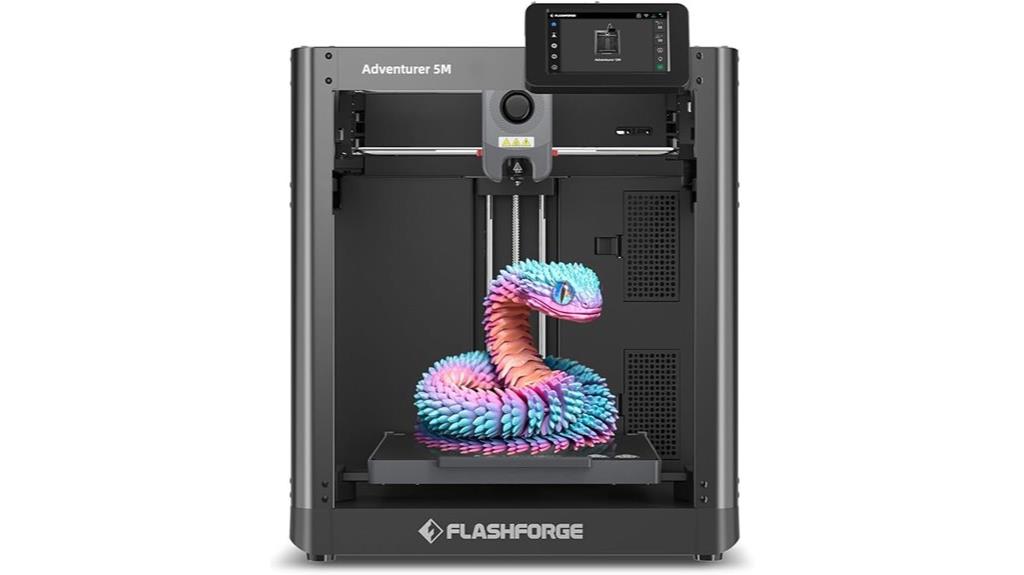
For hobbyists and beginners seeking a reliable, easy-to-use metal 3D printer, the FLASHFORGE Adventurer 5M stands out with its fully automatic bed leveling and rapid setup. Its compact design measures just 15.83 x 14.29 x 17.64 inches, making it ideal for desk use. With a 220x220x220mm build volume, a 280°C direct extruder, and a Core XY structure, it delivers high precision at speeds up to 600mm/s. Features like dual-sided PEI platforms, vibration compensation, and remote monitoring via the Flash Maker app make it user-friendly. Overall, the Adventurer 5M offers fast, reliable performance perfect for prototyping and small-scale production.
Best For: hobbyists and beginners seeking a reliable, easy-to-use metal 3D printer for small projects and prototyping.
Pros:
- Fully automatic bed leveling and quick setup simplify operation.
- Compact size with high precision and fast speeds up to 600mm/s.
- Supports remote monitoring via the Flash Maker app for convenient control.
Cons:
- Limited build volume of 220x220x220mm may restrict larger project sizes.
- Some users experience filament feeding issues or nozzle clogs if not properly maintained.
- Closed slicing environment may limit advanced customization for experienced users.
16K Resin 3D Printer GK3 Ultra with Large Build Volume
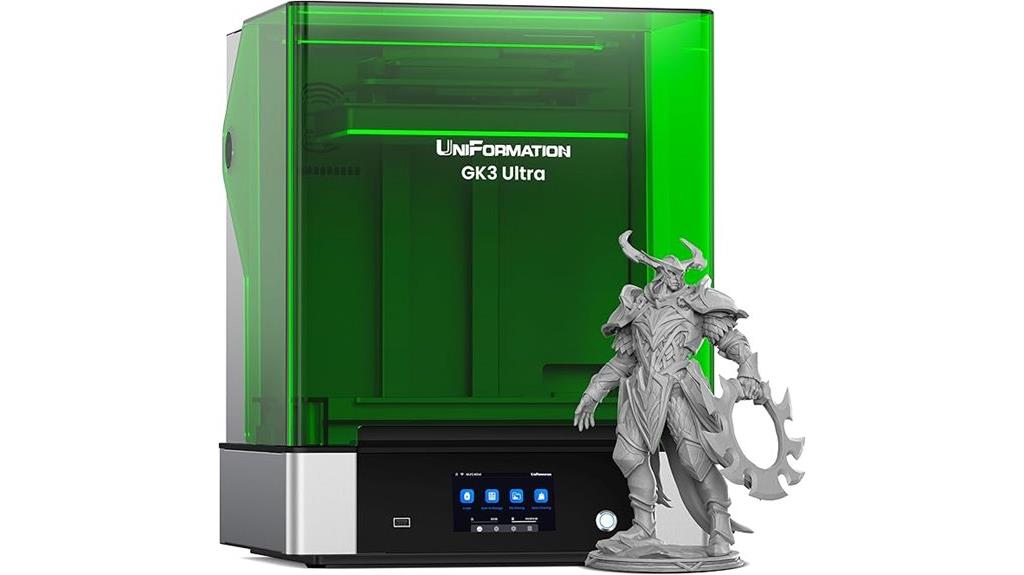
The GK3 Ultra stands out with its impressive 16K resin resolution and large build volume, making it an ideal choice for professionals and hobbyists tackling detailed, sizable projects. Its 300 x 160 x 300mm workspace allows for large models or multiple components in one go. The 13.5-inch LCD screen delivers sharp detail with a pixel size of 20 x 26 micrometers, ensuring high-quality finishes. Designed with stability and user convenience in mind, it features an ultra-stable Z-axis, automatic resin feeding, and a smart heating system. Compact yet powerful, the GK3 Ultra is perfect for creating precise, large-scale resin prints at a desk.
Best For: hobbyists and professionals seeking high-resolution, large-scale resin 3D printing with reliable performance and user-friendly features.
Pros:
- Large build volume of 300 x 160 x 300mm ideal for sizable projects or multiple components
- 16K LCD resolution with 20 x 26 micrometer pixel size for detailed, smooth finishes
- Advanced mechanical design with ultra-stable Z-axis and automatic resin feeding for consistent results
Cons:
- Relatively heavy at 26.4 pounds, which may impact portability and setup flexibility
- Larger dimensions (21.71 x 26.4 x 19.5 inches) require ample space for operation
- Higher price point compared to smaller or less advanced resin printers
FLASHFORGE AD5M 3D Printer, CoreXY 600mm/s with Auto Leveling and High-Temp Extruder
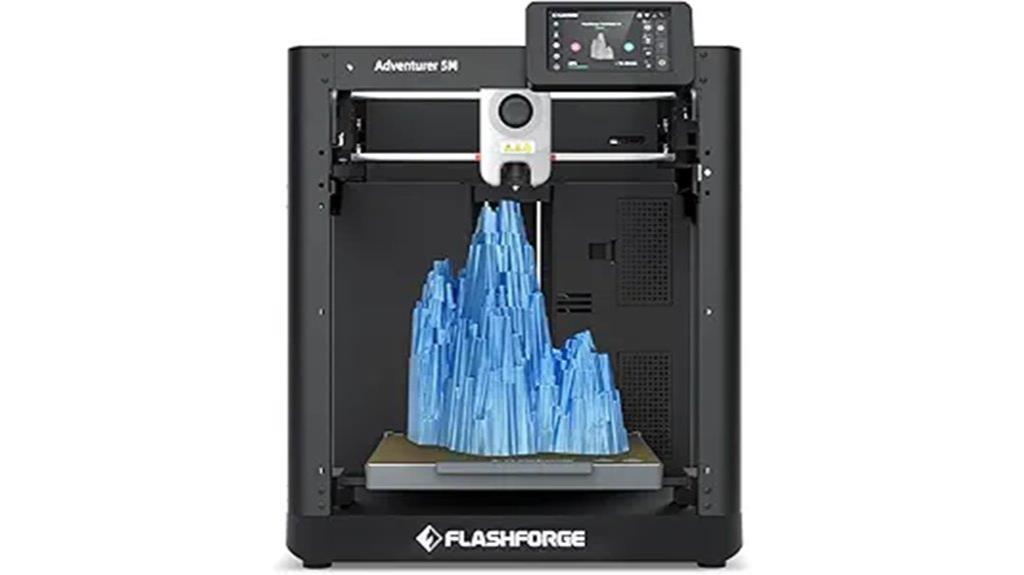
The FlashForge AD5M stands out as an ideal choice for those who need rapid prototyping and high-volume production from a desktop 3D printer. Its coreXY design can reach speeds up to 600mm/s, making fast iterations effortless. The high-temp extruder supports materials up to 280°C, perfect for functional parts and advanced filaments. Auto bed leveling with a pressure sensor guarantees consistent first layers, while the quick-swap nozzles enable easy tool changes. With a build volume of 220×220×220mm and user-friendly touchscreen controls, it combines speed and precision in a compact form, suitable for creative professionals demanding reliable, high-quality output.
Best For: makers, engineers, and educators seeking rapid prototyping, high-volume production, and versatile high-temperature 3D printing with easy setup and high-speed performance.
Pros:
- Capable of printing at speeds up to 600mm/s for fast turnaround times
- Supports high-temp materials up to 280°C, enabling functional and advanced prints
- User-friendly touchscreen and quick auto bed leveling streamline operation
Cons:
- Software can be buggy and may crash on some systems, particularly Mac OS
- Noise levels from fans can be noticeable during operation
- Limited filament storage capacity may require additional re-spooling for larger projects
ELEGOO Mars 5 Resin 3D Printer with 4K LCD

If you’re seeking high-detail resin prints at an accessible price, the ELEGOO Mars 5 with its 4K LCD is an excellent choice. It features a mono LCD with COB lighting, delivering precise, detailed models. The automatic, one-click leveling makes setup simple, even for beginners. Its textured bed improves adhesion, while the tilting vat speeds up printing by easing the peel process. The large touchscreen supports glove use, and Wi-Fi allows remote monitoring and control. Although the non-hinged lid can be inconvenient, the sturdy build, smart sensors, and compatibility with ChituBoxPro software make the Mars 5 a versatile, user-friendly option for hobbyists and professionals alike.
Best For: hobbyists and small-scale professionals seeking high-detail, accurate resin prints with user-friendly features and quick setup.
Pros:
- High-resolution 4K mono LCD with COB lighting for detailed models
- Automatic, one-click leveling simplifies calibration for all skill levels
- Wi-Fi connectivity enables remote monitoring and control
Cons:
- Non-hinged lid may be inconvenient for small spaces or frequent access
- Replacement parts like screens and FEP are relatively costly
- Camera visibility can be limited for small or obstructed prints
YOOPAI 3D Printer Filament Storage Rack

For anyone looking to keep their filament collection organized and easily accessible, the YOOPAI 3D Printer Filament Storage Rack offers a practical solution. It features two tiers, holding up to 12 standard 1kg spools—perfect for PLA, ABS, TPU, or PETG filaments. Constructed from durable metal with a stable design, it supports at least 15kg per layer and includes rubber pads to protect surfaces. Lightweight and compact, it fits easily on desks or shelves, with an open design for quick filament identification. Easy to assemble in around 10 minutes, it’s highly rated for durability, capacity, and workspace efficiency, making filament management hassle-free.
Best For: 3D printing enthusiasts and professionals seeking an organized, space-efficient way to store multiple filament spools for easy access and workflow improvement.
Pros:
- Durable metal construction supports up to 15kg per layer, ensuring long-lasting stability.
- Open design allows quick identification and easy access to filament spools.
- Compact and lightweight, fitting comfortably on desks or shelves to save space.
Cons:
- Assembly instructions are only printed on the box, which may be less convenient for some users.
- Slight instability when the rack is empty, though it stabilizes once loaded.
- Limited to holding 12 spools; may not accommodate larger or additional filament collections.
3D Printers Tina2 Basic, Fully Assembled and Auto Leveling 3D Printer for Beginners and Kids
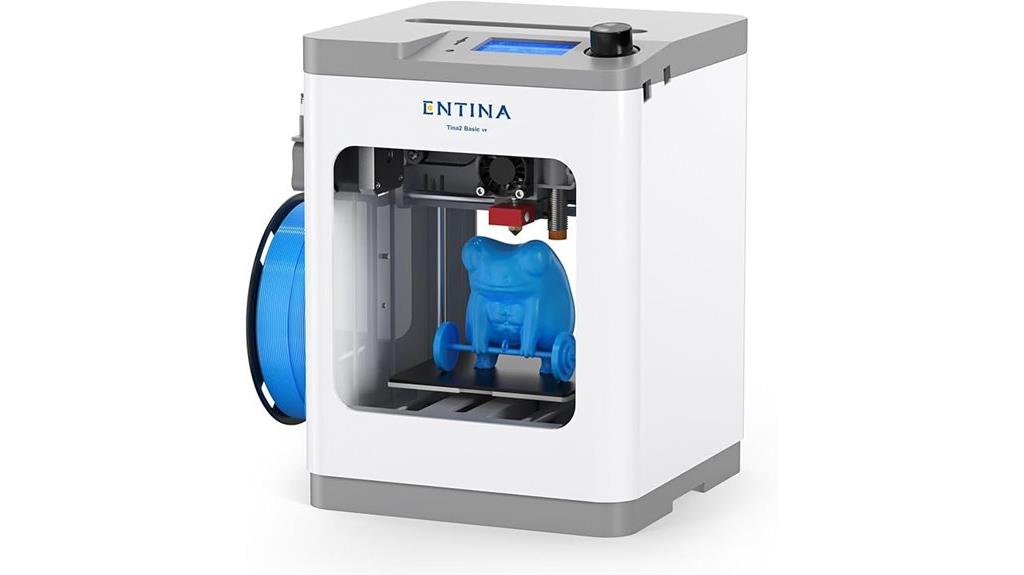
Designed specifically for beginners, kids, and educational settings, Tina2 Basic offers a fully assembled, auto-leveling 3D printer that simplifies the printing process. Its compact size and lightweight build make it perfect for classrooms, homes, or small offices. The 100x105x100mm build volume handles small projects easily. Features like a 2.4-inch LCD screen, Wiibuilder software, and offline printing via MicroSD ensure user-friendly operation. Dual Z-axis rails provide high precision and stability. The magnetic removable build plate makes model removal simple. No manual leveling is needed; the intelligent system adjusts the bed automatically, making 3D printing accessible for all skill levels.
Best For: beginners, kids, and educational environments seeking an easy-to-use, compact 3D printer for small projects and learning.
Pros:
- Fully assembled and auto-leveling for effortless setup and operation
- Compact, lightweight design ideal for classrooms, homes, and offices
- Supports offline printing with MicroSD card and features a user-friendly LCD interface
Cons:
- Limited build volume of 100x105x100mm, suitable only for small projects
- No heated bed, restricting material options mainly to PLA and flexible filaments
- Slightly noisy operation may be disruptive in silent environments
FLASHFORGE Adventurer 5M 3D Printer
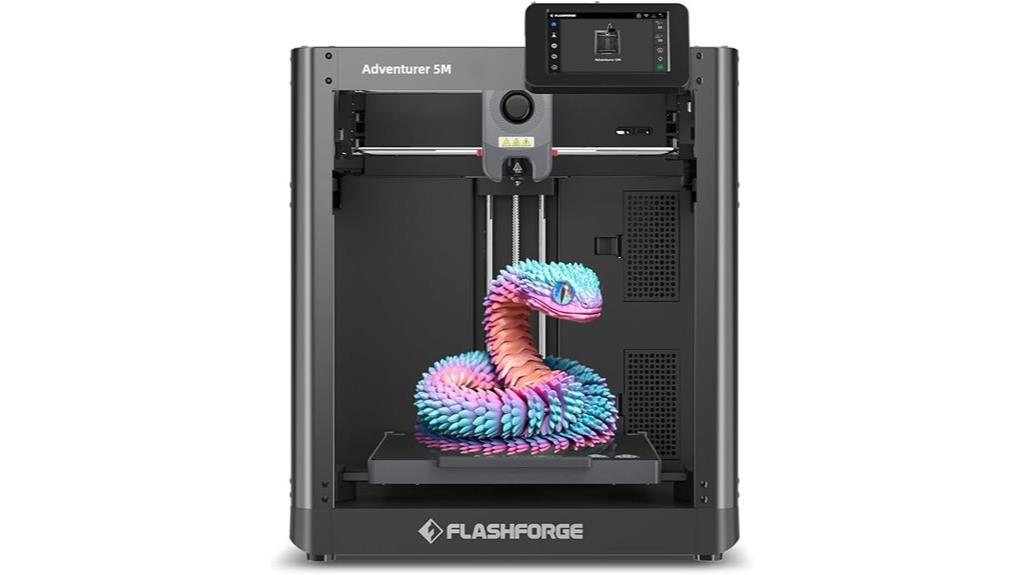
The FLASHFORGE Adventurer 5M stands out as an excellent choice for beginners and hobbyists seeking a reliable, high-speed 3D printer that’s easy to operate. Its compact all-metal design, automatic bed leveling, and rapid 600mm/s travel speeds make it ideal for quick, precise prints. The 280°C direct extruder with a detachable nozzle ensures versatility, while dual PEI platforms simplify print removal. With user-friendly features like remote monitoring via the Flash Maker app and minimal setup, it’s perfect for those new to 3D printing. Despite its small build volume, it delivers consistent results, making it a smart, low-maintenance addition to any creative workspace.
Best For: hobbyists and beginners seeking a reliable, easy-to-use 3D printer with high-speed capabilities and minimal setup.
Pros:
- User-friendly with automatic bed leveling and straightforward operation
- High-speed printing up to 600mm/s with precise movement thanks to Core XY structure
- Compact, all-metal design with easy print removal via dual PEI platforms
Cons:
- Limited build volume of 220x220x220mm may restrict larger projects
- Closed slicing environment could limit customization for advanced users
- Some users report filament feeding issues or nozzle clogs if not properly maintained
Creality CR-Ferret SE 3D Scanner for 3D Printing
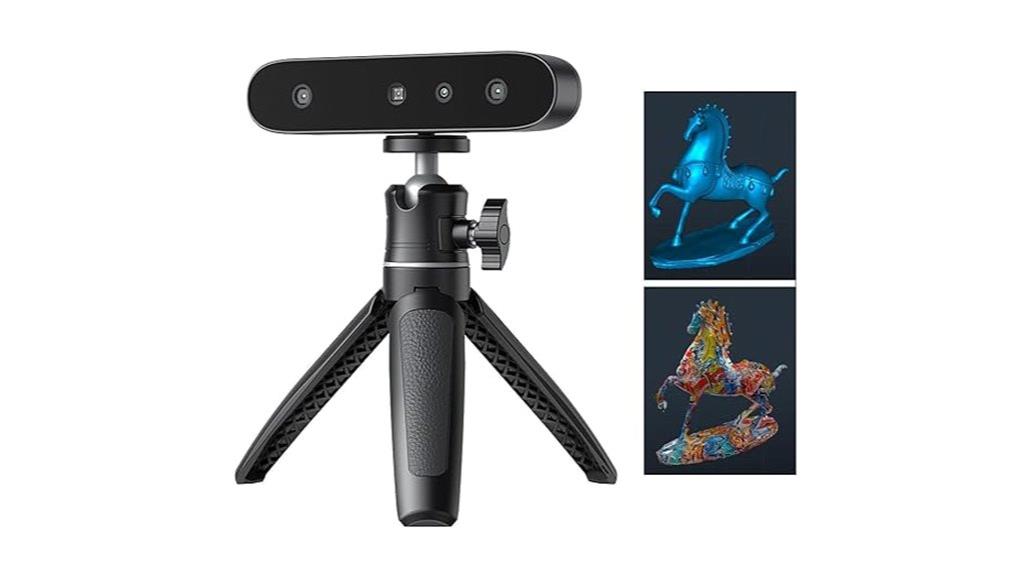
The Creality CR-Ferret SE 3D Scanner stands out with its impressive accuracy of up to 0.1mm and a scanning speed of 30FPS, making it ideal for anyone who needs detailed, high-quality scans quickly. Its one-shot 3D imaging technology guarantees stable, error-free captures even if your hands shake or you move rapidly. The built-in 2MP color camera records vivid textures and true-to-life colors, bringing models to life. Supporting a flexible scan range from 150mm to 2000mm, it handles medium to large objects effortlessly. Plus, it scans black or metallic surfaces without powders, simplifying your workflow and saving time.
Best For: hobbyists, educators, and professionals seeking high-precision 3D scans of medium to large objects with ease and color detail.
Pros:
- High accuracy of up to 0.1mm ensures detailed and precise models
- Rapid scanning at 30FPS speeds for efficient workflow
- Capable of capturing vivid textures and true-to-life colors with the built-in 2MP camera
Cons:
- May be less effective with highly reflective or very dark surfaces without proper calibration
- Larger objects approaching the 2000mm range might require multiple scans for complete coverage
- The device’s complexity might require some initial learning curve for beginners
TRONXY CRUX 1 Mini 3D Printer for Beginners
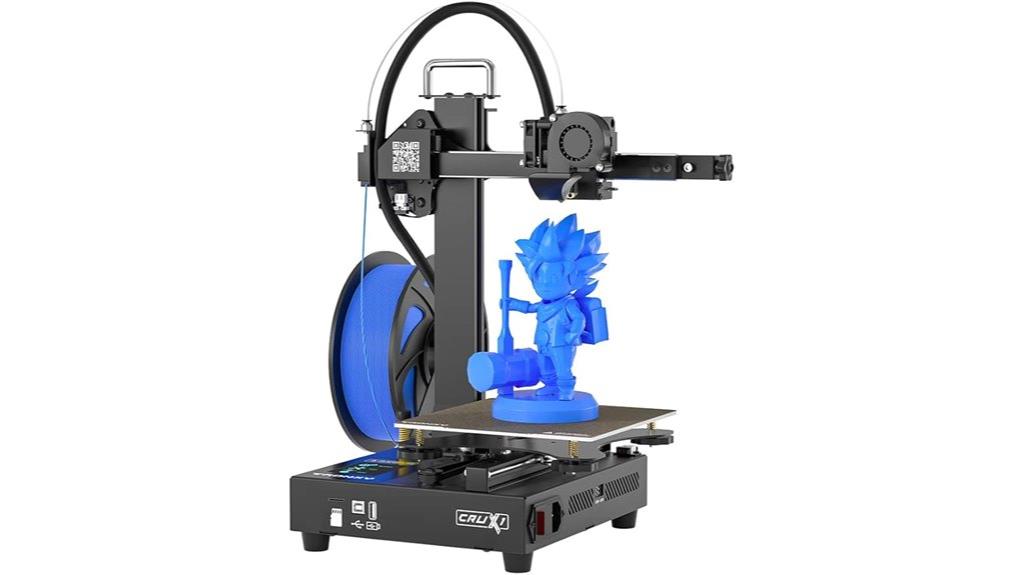
If you’re new to 3D printing and want an easy, portable option, the TRONXY CRUX 1 Mini stands out as a perfect choice. Weighing just 5.8kg, it’s compact enough for small spaces and quick to set up—ready to print within minutes thanks to its 95% pre-installed components. The 2.8-inch full-color touchscreen supports eight languages, making operation straightforward for beginners. Its integrated modular design with a built-in power supply ensures safety and easy assembly. With a 7.08-inch cube print volume, a durable dual-axis guide rail system, and compatibility with common filaments, it’s ideal for educational projects and creative hobbies.
Best For: beginners, hobbyists, and teens seeking a portable, easy-to-use 3D printer for creative and educational projects.
Pros:
- Quick setup with 95% pre-installed components, ready to print within minutes
- Compact and lightweight design (5.8kg) ideal for small spaces and portability
- User-friendly 2.8-inch full-color touchscreen supporting eight languages
Cons:
- Limited to a print volume of 7.08 inches on each side, suitable for smaller projects
- May require some familiarity with filament compatibility and basic assembly
- Features primarily geared toward beginners, which might limit advanced customization options
ELEGOO Neptune 3 Pro FDM 3D Printer

Looking for a compact, reliable 3D printer that delivers high-quality results without breaking the bank? The ELEGOO Neptune 3 Pro fits the bill perfectly. It boasts an 8.85×8.85×11-inch build volume, a silent STM32 motherboard, and dual Z-axis lead screws for stable, precise movement. Features like auto bed leveling, a removable magnetic build plate, and support for various filaments—PLA, TPU, PETG, ABS—make it versatile and user-friendly. Its dual-gear direct extruder ensures smooth filament feeding, reducing clogging issues. Weighing around 22 pounds, it’s compact enough for most desks while delivering impressive print quality. Overall, it’s a dependable choice for creators seeking affordability and performance.
Best For: hobbyists, beginners, and small-scale creators seeking an affordable, reliable 3D printer with high-quality output and user-friendly features.
Pros:
- Easy assembly with pre-assembled components and a complete toolkit
- High-precision auto bed leveling and stable dual Z-axis for consistent first layers
- Supports multiple filament types including PLA, TPU, PETG, and ABS
Cons:
- Manual lacks detailed setup instructions for magnetization and print bed removal
- Occasional nozzle clogging issues requiring routine maintenance
- Slightly limited build volume compared to larger professional printers
Factors to Consider When Choosing Deskmetal 3D Printers

When selecting a deskmetal 3D printer, I consider factors like printing speed and volume to make certain it meets my project needs. Material compatibility and ease of calibration are also key for smooth operation, while software compatibility affects workflow efficiency. Finally, build quality and durability determine how well the printer will hold up over time.
Printing Speed and Volume
Choosing the right deskmetal 3D printer involves carefully balancing printing speed and volume, as both markedly impact your workflow. Faster speeds, like 600mm/s, enable quick production but can reduce detail and precision if not managed properly. Larger build volumes let you create bigger parts or multiple items at once, boosting productivity. Achieving high speed and volume together requires a robust motion system, such as CoreXY architecture, to maintain accuracy. Faster printing also demands powerful extruders and cooling systems to prevent issues like warping or layer separation. Striking the right balance ensures you optimize quality, material use, and efficiency. Prioritizing speed versus volume depends on your project needs, but a well-balanced system enhances overall performance and keeps your creative process smooth.
Material Compatibility Options
Selecting a metal 3D printer that offers broad material compatibility can substantially expand your project options. Look for a model that supports a wide range of filaments like PLA, ABS, PETG, TPU, and nylon, so you’re prepared for diverse applications. Check if the hotend temperature range meets your needs—ideally up to 280°C or higher—to handle advanced, high-temperature materials. Consider whether the printer accommodates specialty filaments like carbon fiber or composite materials, which usually require reinforced nozzles or extruders. Also, evaluate the extruder type—direct drive or Bowden—since flexibility and filament handling differ between them, especially with flexible or specialty materials. Lastly, verify there are compatible nozzles and third-party filament options available, giving you more flexibility and cost efficiency in your material choices.
Ease of Calibration
Ease of calibration is a crucial factor that can save you time and frustration during setup and routine maintenance. Auto-leveling systems that perform a full bed scan in under 30 seconds make calibration quick and hassle-free, allowing me to get started faster. Fully automatic calibration features handle Z-offset adjustments, bed leveling, and probe-based surface detection, ensuring consistent first layers without manual effort. Manual calibration, involving leveling with a paper or feeler gauge, can take 10-15 minutes and demands precision, which can be tedious. Firmware with auto-calibration support offers user prompts and quick test routines to verify accuracy before each print, maintaining quality over time. Regular calibration checks are essential, especially if the printer is moved or components are replaced, but modern systems make this process far simpler.
Software Compatibility Ease
Ensuring that a deskmetal 3D printer supports popular slicing software like Cura, Simplify3D, or PrusaSlicer is essential for a smooth workflow. Compatibility with these programs means I can prepare files efficiently without worrying about conversion issues. I also check if the printer uses standard file formats like G-code or STL, ensuring easy integration with CAD and slicing tools. Firmware flexibility matters too; I prefer printers that allow firmware updates or custom flashes, keeping my options open as software evolves. Additionally, I look for proprietary software that can import and export files seamlessly from common modeling platforms. Community-developed plugins, profiles, and integrations are a bonus, as they can streamline my workflow and resolve potential compatibility hiccups. This focus helps me stay efficient and adaptable.
Build Quality Durability
A sturdy frame crafted from metal or high-quality alloys is vital for the durability and stability of a deskmetal 3D printer. It guarantees the machine remains steady during precise printing tasks and resists deformation over time. Precision-machined components and reinforced joints play an indispensable role in reducing wear and tear, especially during long printing sessions. An enclosure or protective casing made of durable metal not only shields the printer from external impacts but also guards against environmental factors like dust and humidity. Reliable movement systems, such as metal guide rails and solid lead screws, guarantee consistent performance and longevity. Additionally, well-designed heat management components, like metal hotends and heat sinks, extend the lifespan of critical parts by resisting deformation under high temperatures.
Maintenance Requirements
Choosing a deskmetal 3D printer involves considering how much maintenance it will require to keep it running smoothly. Regular tasks include cleaning the print bed, checking for filament clogs, and inspecting moving parts for smooth operation. Some models need periodic lubrication of guide rails and lead screws to maintain precision and reduce wear. Over time, components like nozzles and print heads may need replacing, especially when printing with abrasive or high-temperature materials. Firmware updates and calibration are also essential to ensure ideal performance and accuracy. Proper maintenance routines can extend your printer’s lifespan, minimize downtime, and improve print quality. While some tasks are straightforward, others demand more attention and technical know-how, so evaluating how much effort you’re willing to invest is key when choosing a model.
Price and Value
When evaluating deskmetal 3D printers, it is vital to weigh their features, build quality, and performance against their price to determine true value. Higher-priced models often include advanced features like automatic calibration, multi-material support, and faster speeds, which can boost overall utility. It’s necessary to consider the total cost of ownership, including maintenance, spare parts, and software, to see if the initial investment pays off long-term. While budget options may lack premium features, they can still produce excellent results for beginners or targeted applications, offering better value for entry-level users. Investing in a well-reviewed, feature-rich printer might cost more upfront but can deliver superior performance and durability, reducing the need for upgrades or repairs over time.
Frequently Asked Questions
How Do Metal 3D Printers Compare in Cost to Traditional Manufacturing Methods?
When comparing metal 3D printers to traditional manufacturing, I find that initial costs are higher for the printers themselves. However, they often save money over time by reducing material waste and speeding up prototyping. For small batches or custom parts, 3D printing can be more economical. So, while the upfront investment is significant, the overall costs can be lower, especially for complex or limited production runs.
Are Compact Metal 3D Printers Suitable for Industrial-Scale Production?
I’ve looked into this, and while compact metal 3D printers are fantastic for prototyping and small batches, they aren’t quite suited for large-scale industrial production yet. They often lack the speed and volume capacity needed for high-demand manufacturing. However, advancements are happening fast, so I believe in a few years, these compact machines might bridge that gap and become more viable for bigger production needs.
What Safety Features Are Essential for Desktop Metal 3D Printing?
When it comes to desktop metal 3D printers, safety features are vital. I always look for enclosed chambers to contain fumes and hot materials, automatic shut-offs for overheating, and proper ventilation systems. Eye protection and error alerts are also essential. These features protect me while I focus on my projects, ensuring a safe environment. Prioritizing safety helps me avoid accidents and keeps my workspace secure and productive.
How Does Print Speed Impact the Quality of Metal 3D Printed Parts?
Speed and skill markedly influence the quality of metal 3D prints. When I increase print speed, I risk sacrificing detail and precision, leading to rougher surfaces or inaccuracies. Conversely, slower speeds allow for meticulous layer placement, resulting in polished, perfect parts. It’s a delicate dance between duration and detail—finding that sweet spot where speed serves quality, not sacrifice. Balancing both guarantees ideal outcomes for your creative projects.
Can Desktop Metal 3D Printers Handle Complex Geometries Effectively?
When it comes to handling complex geometries, I’ve found that desktop metal 3D printers are quite capable, especially newer models designed for precision. They excel at intricate details and challenging shapes, thanks to advanced print heads and software. While they might not match industrial machines in size, I believe they’re effective tools for creative professionals wanting detailed, complex metal parts right on their desks.
Conclusion
So, while these metal 3D printers might be considered compact powerhouses, they’re really more like inviting gateways to endless creativity right at your desk. With a little patience and curiosity, you’ll find they gently open doors to impressive projects, making your work feel less like a task and more like an exciting adventure. Embrace the journey, and soon you’ll discover that even small machines can hold big possibilities.

